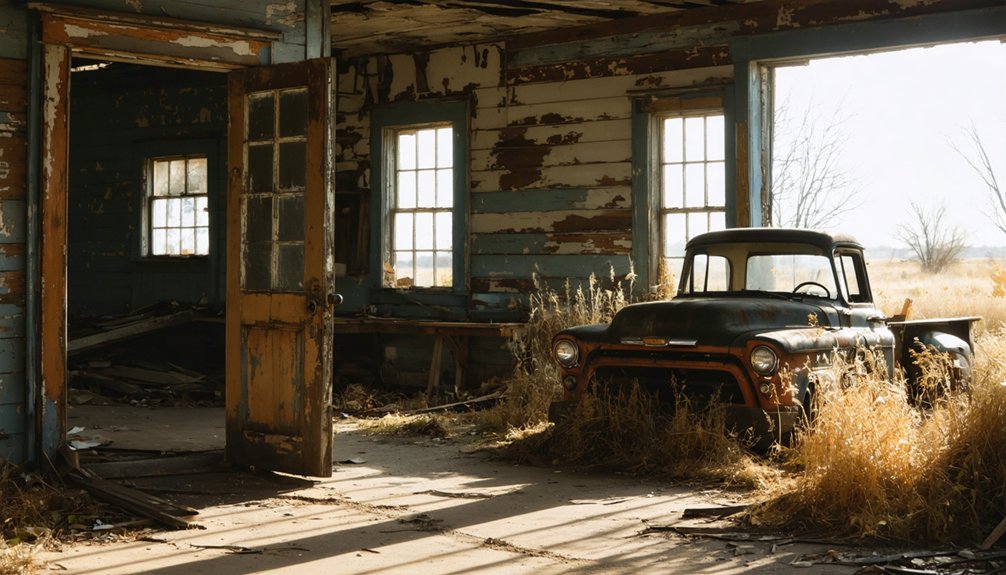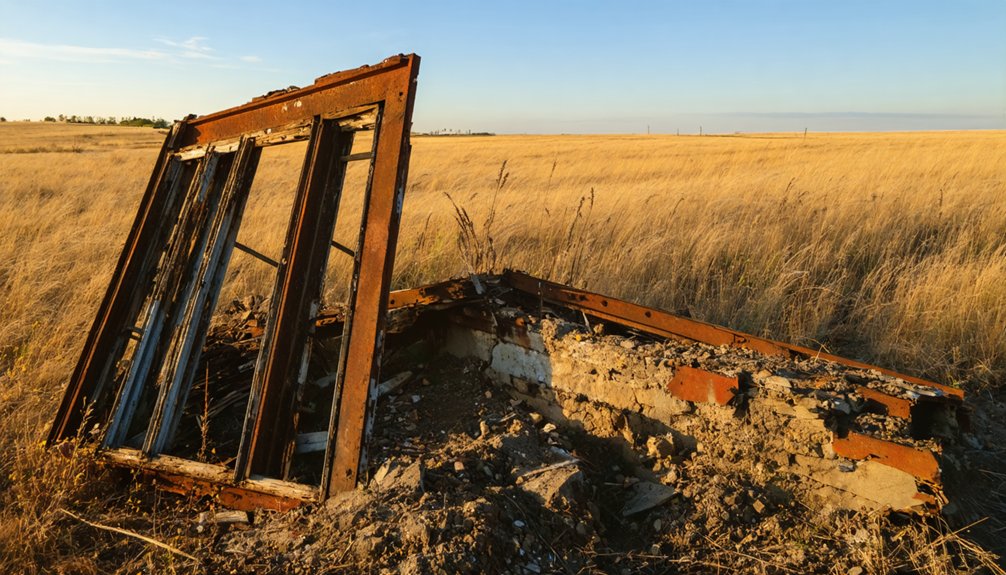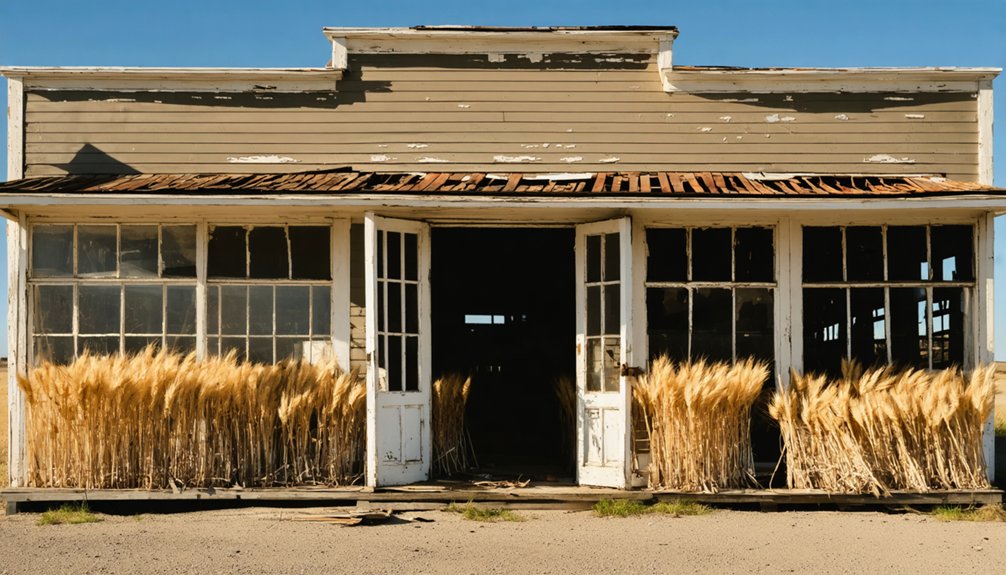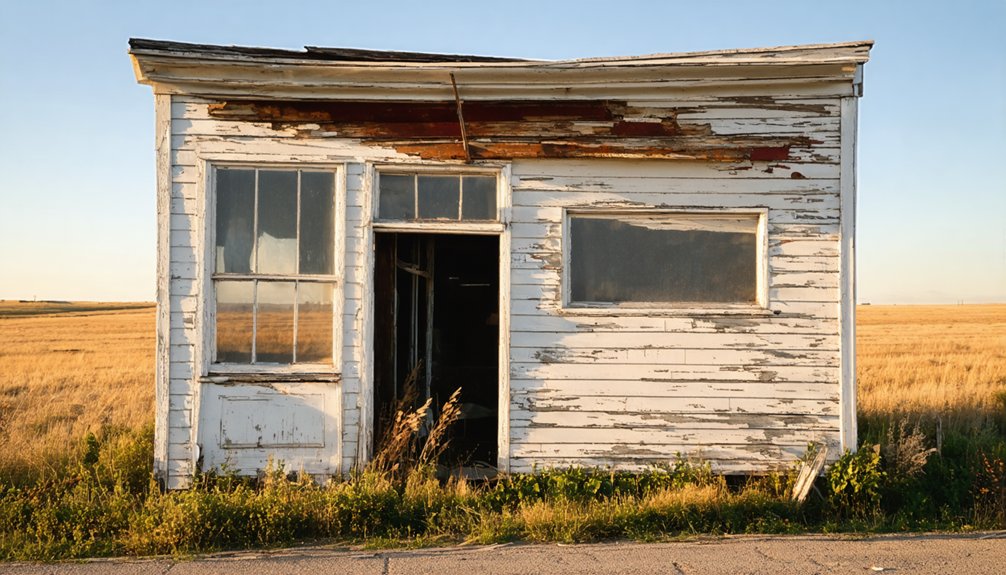You’ll find Mason’s story begins in 1912 when hopeful settlers established this South Dakota prairie town during the Dakota Boom period. The community thrived through the 1930s with a bustling post office, strong agricultural base, and close-knit immigrant population. However, the combined effects of the Great Depression, Dust Bowl, and agricultural mechanization led to its abandonment. Today, only scattered remnants mark where this once-promising settlement stood, with its complete history preserved in state museum archives.
Key Takeaways
- Mason, South Dakota was established in 1912 as a hopeful transportation hub but failed to secure crucial railway connections.
- The town thrived between 1912-1930s with a close-knit community centered around its post office, schools, and local businesses.
- Agricultural mechanization and the Great Depression forced smaller farms to close, driving residents away and decimating the local economy.
- The abandonment of railroad lines after World War II isolated Mason, leading to its eventual transformation into a ghost town.
- Today, few physical remnants remain of Mason, with most structures vanished and the prairie reclaiming the former settlement’s location.
The Mason Family Legacy
When Robert Mason immigrated to America in 1630 alongside Governor John Winthrop’s company, he established what would become a significant family legacy spanning four centuries and stretching from Massachusetts to South Dakota.
You’ll find the Mason family’s historical significance woven throughout America’s development, from Lemuel Saunders Mason’s enterprising spirit in operating grist and lumber mills in Belchertown to Norman David Mason’s life in Huron, South Dakota. After settling in Roxbury, Massachusetts, Robert became an original landholder in Dedham following his wife’s death in 1637. The family later expanded their skills to include masonry construction, contributing to many early buildings in the region.
The family’s journey reflects the broader American experience of westward expansion and economic opportunity. Through generations, they’ve shaped communities and contributed to local economies.
From Lyman Gates Mason I’s strategic move to Worcester for employment to Theodore E Mason’s role in South Dakota’s development, you can trace how this family embodied the American spirit of mobility and adaptation.
Early Settlement and Town Planning
You’ll find that Mason’s initial settlement in 1912 followed a straightforward rural town planning approach, establishing basic infrastructure with a post office as its central facility.
Like many towns of its era, Mason attempted to establish itself as a transportation hub, but unlike the success of the historic Mason streetcar line, the town never secured vital railway connections.
The town’s residential layout remained sparse throughout its brief existence, with homes scattered across the planned settlement area rather than concentrated in a dense core.
Similar to Deadwood’s challenges in the 1870s, Mason struggled with illegal settlement issues that complicated its early development.
While Mason’s founders implemented a basic framework for growth, the limited development of essential infrastructure and transportation links ultimately restricted the town’s potential for expansion.
Early Population Growth Patterns
The early settlement of Mason emerged through several key population growth factors, including the arrival of Norwegian, German, and Russian immigrants who established farmsteads under the Homestead Act.
During the Dakota Boom period, rapid development and population increases occurred as the completion of railways drew more settlers to the region.
You’ll find that settlement patterns initially centered around available transportation routes, particularly government trails and newly constructed rail lines that enhanced accessibility to the region.
The town’s population demographics shifted as diverse groups claimed 160-acre parcels, with many settlers building sod houses due to limited timber resources.
You can trace how the community grew around essential infrastructure, including schools and churches, while farming advancements like gasoline-powered tractors helped attract more residents.
The introduction of irrigation projects and improved agricultural methods further supported the town’s expansion, though land ownership contests sometimes disrupted established settlement patterns.
Local fur traders established temporary outposts in the area before permanent settlement began, creating early trade networks with Native American tribes.
Town Development Framework
As Mason emerged from unsettled land into an organized community, its formal development began with the 1912 platting that established the town’s legal framework and spatial organization.
The urban planning process created defined boundaries for public spaces, business districts, and residential areas, giving potential settlers clear paths to land ownership and development rights.
You’ll find that Mason’s layout followed typical early 20th-century town planning principles, with a centralized business district anchored by the post office.
The town’s infrastructure expanded to support local economic activities, with roads connecting to neighboring settlements and basic services established to attract residents.
Similar to many Black Hills communities, Mason’s careful planning reflected the era’s optimism for growth, though Mason’s eventual decline would leave these well-organized streets and lots largely abandoned by 1940.
Life in the Bustling Years
During Mason’s peak years between 1912 and the late 1930s, life centered around a close-knit community where residents forged strong bonds through shared experiences and mutual support.
You’d find yourself part of a vibrant social fabric where community gatherings and school events brought everyone together, creating lasting connections between neighbors.
Living in Mason meant embracing the rhythms of rural life. You’d rely on the local post office for communication, visit the general store for supplies, and participate in the seasonal cycles of farming and ranching. Much like Awanka’s history, the town supported two busy hotels that served travelers and temporary workers.
Church services and school activities weren’t just social occasions – they were the heartbeat of daily life. Despite the isolation from larger towns, you’d experience the freedom of self-sufficiency while knowing your neighbors would always lend a helping hand when needed. Like many South Dakota communities that later became ghost towns, Mason’s residents created a thriving culture that preserved their stories through artifacts and buildings.
Post Office Operations and Services
From its establishment in 1912, Mason’s post office stood as an indispensable communication hub where you’d find residents gathering to collect mail, exchange packages, and maintain connections with the outside world.
Like many rural post offices, Mason’s facility mirrored the success seen in towns such as Barnard, which also received its commission in the early 1910s.
The facility delivered significant postal services for 28 years, helping you stay connected with family, friends, and business associates beyond Mason’s borders.
For nearly three decades, Mason’s post office kept residents linked to their loved ones and business contacts outside town.
You’d witness the post office serving as more than just a mail center – it became a cornerstone of community connection where neighbors would meet and share news.
When the facility closed its doors in 1940, you’d have seen it as a clear sign of Mason’s declining population and diminishing importance.
Like many small South Dakota towns, the loss of postal services marked a pivotal moment in Mason’s shift toward ghost town status.
Economic Challenges and Population Decline

The rapid decline of Mason’s agricultural economy mirrored broader regional challenges as both farmers and ranchers faced mounting economic pressures during the Great Depression and Dust Bowl era.
You’ll find that the town’s isolation intensified when critical transportation routes failed to materialize, particularly the planned railroad connection that would have sustained commerce and population growth.
The combined impact of agricultural crisis and lost transport access proved devastating, as families were forced to abandon their properties and seek opportunities in more economically viable locations.
Agricultural Industry Crisis
As agricultural mechanization revolutionized farming practices across South Dakota in the mid-20th century, Mason experienced a profound economic transformation that would ultimately contribute to its decline.
You’d have witnessed larger farms absorbing smaller operations, as mechanization effects reduced the need for farm labor and drove rural populations away from agricultural communities like Mason.
Despite agricultural subsidies introduced during the New Deal era, many local farmers couldn’t keep pace with the economic pressures of modernization.
You’ll understand how the drive for efficiency forced smaller operations to sell out to larger farms that could afford expensive machinery and better handle market volatility.
The result was a devastating cycle: fewer farmers meant fewer residents, which led to decreased local business activity and, ultimately, Mason’s transformation into a ghost town.
Transportation Routes Disappeared
While agricultural decline dealt a significant blow to Mason’s importance, changes in transportation infrastructure would deliver an equally devastating impact.
If you’d studied Mason’s transportation history, you’d find that railroads once served as its economic lifeline, connecting the town to crucial commerce and passenger routes throughout South Dakota.
When railroad companies began abandoning their lines after World War II, Mason’s fate was sealed.
You can trace the town’s rapid decline to this pivotal shift in transportation patterns. The economic impact was swift and severe – as rail services disappeared, so did the town’s ability to ship goods, receive mail, and maintain business connections.
The rise of highways and truck transport created a new paradigm that Mason couldn’t adapt to, leaving it increasingly isolated from the modern transportation network.
Remnants of a Lost Community
Modern visitors to Mason, South Dakota will find scarce evidence of what once was a vibrant prairie community.
You’ll notice the absence of typical landmarks that usually preserve community memories – no standing church steeples, schoolhouse bells, or storefronts remain to tell the town’s story. The post office, which operated from 1912 to 1940, has vanished along with other civic structures that once defined daily life here.
The cultural significance of Mason lives on primarily as a reflection of the broader pattern of Great Plains depopulation.
While foundations or scattered debris might still mark where buildings once stood, nature has largely reclaimed the settlement. The town’s physical remnants, like its population, have faded into the prairie landscape.
Geographic Features and Location

Located in western South Dakota’s Butte County, the ghost town of Mason sits at coordinates 44°48′53.48″N 103°49′8.67″W within the Northern Great Plains region.
You’ll find the site characterized by gently rolling plains and sparse tree cover, typical of the area’s terrain characteristics. While it’s near the Black Hills, Mason itself rests firmly in the prairie landscape.
The climate patterns you’ll encounter reflect the region’s semiarid nature, with cold winters and warm summers defining the seasonal shifts.
In this stark semiarid landscape, nature’s extremes rule the seasons – from winter’s bitter chill to summer’s scorching embrace.
You won’t find any major rivers or significant water bodies in Mason’s immediate vicinity. The town’s geographic isolation, combined with the challenging environmental conditions of the Plains, played an essential role in its eventual abandonment, much like other ghost towns scattered across South Dakota’s western expanse.
Historical Preservation Efforts
Through the dedicated work of the South Dakota State Historical Society, preservation efforts for Mason rely heavily on Will G. Robinson‘s private files, which provide vital historical documentation of this ghost town.
You’ll find his detailed records at the South Dakota State Museum, where he cataloged Mason among nearly 50 abandoned settlements during his tenure as Secretary from 1945 to 1967.
The State Historic Preservation Office oversees various preservation initiatives that could benefit Mason, including the Deadwood Fund Grant and Federal Tax Incentive programs.
While Mason’s current protection status remains unclear, you can access technical assistance and preservation guidelines through SHPO’s resources.
Local historical societies play an important role in maintaining oral histories and protecting the site’s remaining foundations, though no active archaeological projects are currently underway.
Impact on Butte County’s Heritage

Since its establishment in 1912, Mason has profoundly shaped Butte County’s cultural identity and historical narrative.
You’ll find that this ghost town embodies the region’s pioneering spirit, preserving the legacy of early settlers and their community life through its remaining structures and stories.
Mason’s transformation from a thriving settlement to a ghost town mirrors the broader economic and social changes that have shaped Butte County.
The closure of its post office in 1940 marked a pivotal moment, reflecting shifts in transportation routes and agricultural mechanization.
Today, the site serves as a valuable educational resource, fostering cultural memory through archaeological research and historical interpretation.
You’ll discover that Mason’s enduring presence continues to generate tourism interest, contributing to the county’s heritage-based economy while offering tangible connections to South Dakota’s rural past.
Frequently Asked Questions
What Role Did Native American Tribes Play in Mason’s Early History?
You’ll find limited documented evidence of tribal interactions or cultural influences in Mason’s specific history, though the area was within Sioux territory during their dominance of the South Dakota region.
Were There Any Notable Crimes or Lawless Incidents in Mason?
Ever wonder what crimes haunted Mason? You’ll find that there’s no documented evidence of notable crime incidents or law enforcement conflicts in Mason’s history. The town’s decline was remarkably peaceful and orderly.
What Types of Businesses and Shops Operated During Mason’s Peak Years?
You’d find general stores, blacksmith shops, and saloons among Mason’s historic establishments, while mining supply stores and ore processing operations formed the backbone of the local economy during peak years.
Did Mason Have a School System, and How Many Students Attended?
You’ll find no confirmed records of Mason’s school enrollment or educational facilities, though similar rural South Dakota towns typically had one-room schoolhouses serving between 10-50 students during the early 1900s.
What Natural Disasters or Extreme Weather Events Affected Mason’s Development?
You’ll find that flooding impacts and extreme climate challenges affected Mason, but specific disaster records haven’t survived. The region’s harsh winters and unpredictable weather patterns likely strained the community’s resources.
References
- https://kids.kiddle.co/Mason
- https://alchetron.com/Mason
- https://en.wikipedia.org/wiki/Mason
- https://www.sdpb.org/rural-life-and-history/2023-08-21/some-black-hills-ghost-towns-and-their-origins
- https://www.youtube.com/watch?v=_0WNYsFLSLA
- https://core.ac.uk/download/pdf/345016075.pdf
- https://www.legendsofamerica.com/gt-emergingghosttowns/
- https://en.wikipedia.org/wiki/List_of_ghost_towns_in_South_Dakota
- https://falloutfanon.fandom.com/wiki/Mason
- https://accessgenealogy.com/genealogy/the-mason-family-1590-1949.htm



